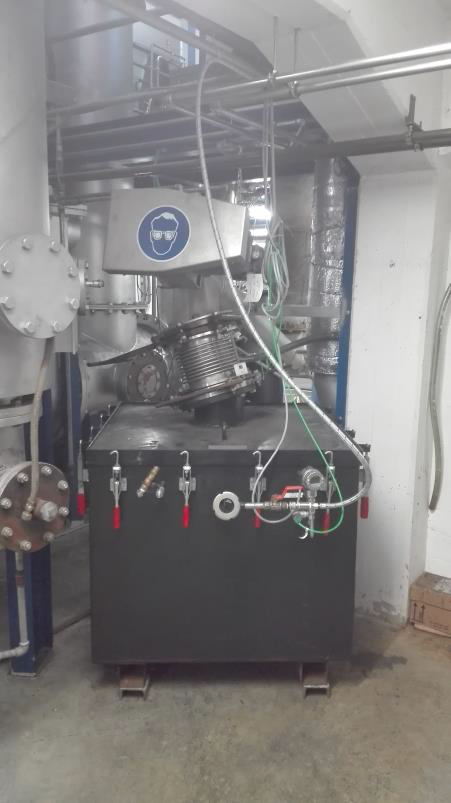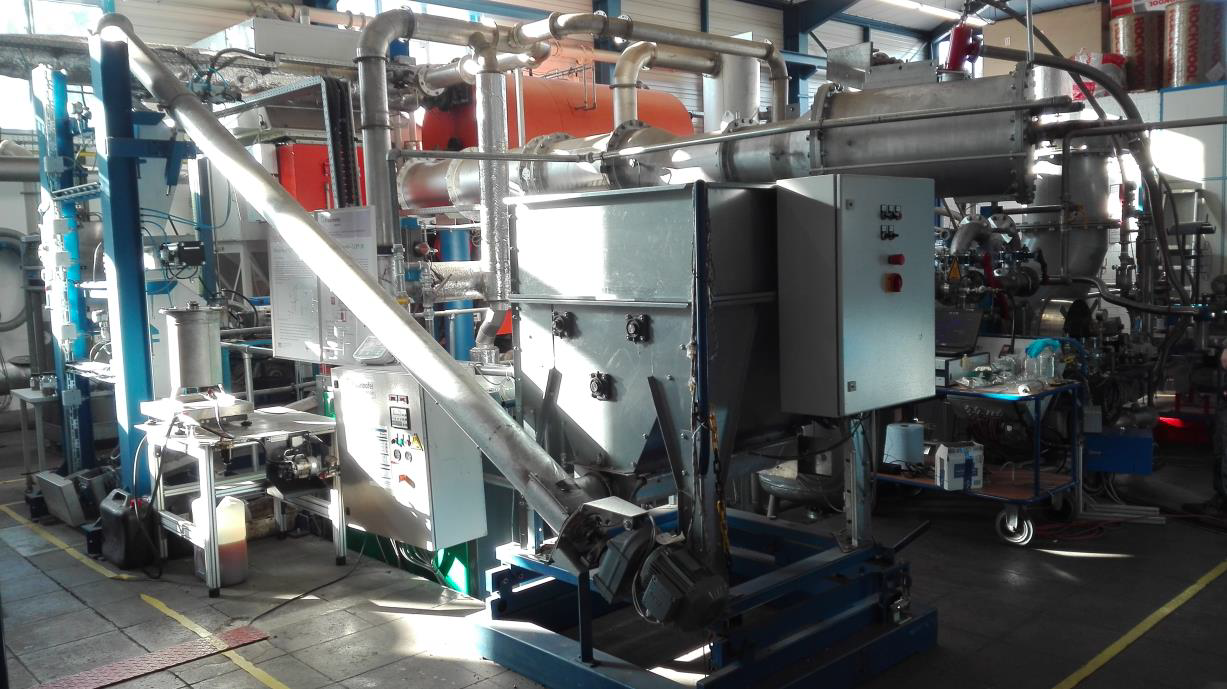TCR – Thermocatalytic Reforming
Periodo: 2017

Sommario
L’obiettivo della sperimentazione eseguita è stato testare le prestazioni della tecnologia TCR (thermocatalytic reforming) presente in un impianto pilota presso il Fraunhofer UMSICHT di Sulzbach-Rosenberg (Germania). Tale tecnologia permette di convertire la biomassa nella seguente serie di prodotti: un residuo solido (biochar) con proprietà analoghe al carbone, un combustibile liquido (biooil) e un combustibile gassoso (syngas). Tra i sottoprodotti sono presenti: polveri, acque di condensa e olio trattenuto dal filtro elettrostatico. La tecnologia può essere applicata ad un ampio spettro di biomasse e altri sottoprodotti.
La sperimentazione è stata condotta monitorando l’impianto durante il trattamento di una specifica biomassa: la biomassa utilizzata era costituita da fanghi di depurazione, precedentemente disidratatati e pellettizzati. Durante il monitoraggio, sono stati eseguiti campionamenti di biomassa in ingresso, char, e biooil, nonché dei principali sottoprodotti. Sui campioni sono state eseguite analisi di composizione elementare e potere calorifico. Sono inoltre stati analizzati i metalli presenti in tracce nei campioni solidi e liquidi. È stata inoltre analizzata la composizione chimica del syngas, dai macrocomponenti ai composti in tracce. Dai dati ottenuti è stato effettuato un bilancio di massa e di energia dell’impianto.
I test hanno dimostrato che il TCR converte differenti tipologie di rifiuti in fonti energetiche utili come il syngas, biooil e biochar. Considerando i fanghi di depurazione, è stato riscontrato che il char comprende una grande porzione del prodotto a causa dell’elevato contenuto di ceneri nel fango: utilizzando il bilancio di massa, è stato riscontrato che da 1 tonnellata di fanghi di depurazione sono prodotti circa 140 kg di gas, 110 kg di olio e 430 kg di char. La massa rimanente è attribuita a ESP-oil (1 kg), ceneri (1%), materiale rimanente (5%), e acqua (27%). È stato determinato il contenuto di metalli nelle acque reflue e non sono state riscontrate criticità. Nel bilancio di massa la percentuale di char è 43,4% e il char costituisce circa il 34% del bilancio energetico. La percentuale di gas nel bilancio di massa è 14% e costituisce circa il 9% del bilancio energetico. La percentuale di olio nel bilancio di massa è l’11% e costituisce circa il 23% del bilancio energetico. Con 1 tonnellata di fanghi di depurazione, è stato calcolato che per syngas, olio e char è prodotta rispettivamente circa 360 kWh, 981 kWh, e 1411 kWh di energia.
L’analisi elementare ha mostrato che il char ottenuto dai fanghi di depurazione è composto dal 29.6% di carbonio, 1.85% di idrogeno, e 3.33% di azoto. Il syngas è composto dal 31.7% di idrogeno, 29.6% di anidride carbonica, 18.1% di azoto, 10.03% di metano, e 8.19% di monossido di carbonio. Il resto del syngas è composto da etano, propilene, etilene+acetilene, propano, n-butano, ossigeno, e isobutano, che sono tutte una piccola percentuale della composizione totale. Ci sono due campioni di olio prelevati, il primo dei quali ha il 72.89% di carbonio, il 5.2% di idrogeno, il 7.39% di azoto, e il 0.2% di zolfo, il secondo ha il 65.76% di carbonio, il 7.19% di idrogeno, il 7.98% di azoto, e nessuna presenza di zolfo. Nessuna altra emissione è stata riscontrata durante i test del TCR.
Sono stati inoltre prelevati ed analizzati campioni di char e biooil ottenuti da altre tipologie di biomassa, ovvero: rifiuti solidi urbani, rifiuti dell’industria cartiera e biomassa legnosa mista a materiale plastico. L’analisi elementare dei campioni è stata integrata con i dati forniti dal Fraunhofer UMSICHT. Una tonnellata di rifiuti solidi urbani produce circa 2029 kWh, 249 kWh, e 1139 kWh di energia rispettivamente da syngas, olio, e char. Usando una tonnellata di carta si produce circa 689 kWh, 606 kWh, e 549 kWh di energia rispettivamente da syngas, olio, e char. Infine, una tonnellata di legno con plastica produce circa 4131 kWh, 591 kWh, e 644 kWh di energia rispettivamente da syngas, olio, e char.

Introduction
This due diligence was commissioned by Rigen srl to the CNR IIA in order to evaluate the performance of the thermocatalytic reforming technology. The technology was developed by Fraunhofer UMSICHT, and is described in patents currently owned by the company Susteen. A prototype plant is currently available for tests in the Sulzbach-Rosenberg branch of Fraunhofer UMSICHT (Germany): previous tests have been already performed by Fraunhofer researchers with several kinds of feedstock.
Summary
Aim of this study is to test the performance of the TCR technology (thermocatalytic reforming), in a pilot plant at Fraunhofer UMSICHT in Sulzbach-Rosenberg (Germany). This technology allows to convert biomass in the following products: a solid residue (biochar) with similar properties to coal, a liquid fuel (biooil) and a gaseous fuel (syngas). The by-products include: dust, condensation water and oil retained by the electrostatic filter. The technology can be applied to a broad spectrum of biomass and other byproducts.
The experiment was conducted by monitoring the plant during the treatment of a specific biomass, i.e. dehydrated pelletized sewage sludge. Samplings of feedstock, char and biooil, as well as by-products, were performed. Elemental composition and calorific value analyses were carried out on the samples. Trace metals in solid and liquid samples were quantified. The chemical composition of the syngas, from macro- to trace compounds, was determined. A mass and energy balance was carried out form the obtained data.
Results obtained
Tests have shown that the TCR converts different types of waste into useful energy sources such as syngas, biooil and biochar.
Mass Balance
Considering the sewage sludge, it has been found that the char includes a large portion of the product due to the high ash content: using the mass balance, it has been found that 1 ton of sewage sludge are converted into about 140 kg of gas, 110 kg of oil and 430 kg of char. The remaining mass is attributed to ESP-oil (1 kg), ash (1%), the remaining material (5%), and water (27%). Metal content in water was determined and no critical issues were observed. In the mass balance the proportion of char is 43.4% and the char constitutes about 34% of the energy balance. The percentage of gas in the mass balance is 14% and represents about 9% of the energy balance. The percentage of oil in the mass balance is 11% and constitutes about 23% of the energy balance.
Energy Balance
With 1 ton of sewage sludge, it has been calculated that for syngas, oil and char is produced respectively about 360 kWh, 981 kWh and 1411 kWh of energy. Due diligence on the “thermocatalytic reforming” (TCR) technology Final report Page 9 of 58
Chemical Analysis
The elemental analysis showed that the char obtained from the sewage sludge is composed of 29.6% carbon, 1.85% hydrogen, and 3:33% nitrogen.
The syngas is composed of 31.7% hydrogen, 29.6% carbon dioxide, 18.1% nitrogen, 10:03% methane, and 8:19% of carbon monoxide. The rest of the syngas is composed of ethane, propylene, ethylene + acetylene, propane, n-butane, oxygen, and isobutane, all of which are a small percentage of the total composition. There are two oil samples, the first of which is 72.89% carbon, 5.2% hydrogen, the 7:39% nitrogen, and 0.2% of sulfur, the second is 65.76% carbon, 7.19% of hydrogen, 7.98% nitrogen, and no presence of sulfur.
The water has been characterized and analysis showed that main values are below the limits set by Decree 152/1999 except for the Cu.
Other Feedstock
Samples of char and biooil obtained from other types of biomass were also collected and analysed. municipal solid waste, waste form paper industry and woody biomass mixed with plastic material.
The elemental analysis of samples has been integrated with the mass data provided by Fraunhofer UMSICHT.
A ton of municipal solid waste produces about 2029 kWh, 249 kWh, 1139 kWh of energy respectively from syngas, oil, and char.
One ton of paper waste produces about 689 kWh, 606 kWh and 549 kWh of energy respectively from syngas, oil, and char.
One ton of plastic and wood produces about 4131 kWh, 591 kWh and 644 kWh of energy respectively from syngas, oil, and char.

Francesco Petracchini
Responsabile Scientifico
